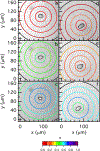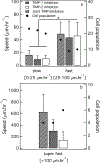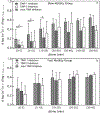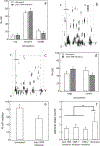Characterizing the dynamic rheology in the pericellular region by human mesenchymal stem cell re-engineering in PEG-peptide hydrogel scaffolds
- PMID: 32773889
- PMCID: PMC7413226
- DOI: 10.1007/s00397-019-01142-2
Characterizing the dynamic rheology in the pericellular region by human mesenchymal stem cell re-engineering in PEG-peptide hydrogel scaffolds
Abstract
During wound healing, human mesenchymal stem cells (hMSCs) migrate to injuries to regulate inflammation and coordinate tissue regeneration. To enable migration, hMSCs re-engineer the extracellular matrix rheology. Our work determines the correlation between cell engineered rheology and motility. We encapsulate hMSCs in a cell-degradable peptide-polymeric hydrogel and characterize the change in rheological properties in the pericellular region using multiple particle tracking microrheology. Previous studies determined that pericellular rheology is correlated with motility. Additionally, hMSCs re-engineer their microenvironment by regulating cell-secreted enzyme, matrix metallopro-teinases (MMPs), activity by also secreting their inhibitors, tissue inhibitors of metalloproteinases (TIMPs). We independently inhibit TIMPs and measure two different degradation profiles, reaction-diffusion and reverse reaction-diffusion. These profiles are correlated with cell spreading, speed and motility type. We model scaffold degradation using Michaelis-Menten kinetics, finding a decrease in kinetics between joint and independent TIMP inhibition. hMSCs ability to regulate microenvironmental remodeling and motility could be exploited in design of new materials that deliver hMSCs to wounds to enhance healing.
Keywords: Michaelis-Menten kinetics; Multiple particle tracking microrheology; cellular degradation; matrix metalloproteinases; polymeric hydrogel scaffold; tissue inhibitor of metalloproteinases.
Figures






Similar articles
-
Rheological characterization of dynamic remodeling of the pericellular region by human mesenchymal stem cell-secreted enzymes in well-defined synthetic hydrogel scaffolds.Soft Matter. 2018 Apr 25;14(16):3078-3089. doi: 10.1039/c8sm00408k. Soft Matter. 2018. PMID: 29667686 Free PMC article.
-
Determining How Human Mesenchymal Stem Cells Change Their Degradation Strategy in Response to Microenvironmental Stiffness.Biomacromolecules. 2020 Aug 10;21(8):3056-3068. doi: 10.1021/acs.biomac.0c00432. Epub 2020 Jul 6. Biomacromolecules. 2020. PMID: 32559386 Free PMC article.
-
Role of Cell-Mediated Enzymatic Degradation and Cytoskeletal Tension on Dynamic Changes in the Rheology of the Pericellular Region Prior to Human Mesenchymal Stem Cell Motility.ACS Biomater Sci Eng. 2018 Feb 12;4(2):468-472. doi: 10.1021/acsbiomaterials.7b01005. Epub 2018 Jan 16. ACS Biomater Sci Eng. 2018. PMID: 29862316 Free PMC article.
-
Human mesenchymal stem cell-engineered length scale dependent rheology of the pericellular region measured with bi-disperse multiple particle tracking microrheology.Acta Biomater. 2021 Feb;121:405-417. doi: 10.1016/j.actbio.2020.11.048. Epub 2020 Dec 3. Acta Biomater. 2021. PMID: 33278674 Free PMC article.
-
Role of TIMPs (tissue inhibitors of metalloproteinases) in pericellular proteolysis: the specificity is in the detail.Biochem Soc Symp. 2003;(70):65-80. doi: 10.1042/bss0700065. Biochem Soc Symp. 2003. PMID: 14587283 Review.
Cited by
-
A Rheological Study on the Effect of Tethering Pro- and Anti-Inflammatory Cytokines into Hydrogels on Human Mesenchymal Stem Cell Migration, Degradation, and Morphology.Biomacromolecules. 2024 Aug 12;25(8):5121-5137. doi: 10.1021/acs.biomac.4c00508. Epub 2024 Jul 3. Biomacromolecules. 2024. PMID: 38961715 Free PMC article.
-
Measuring the Effects of Cytokines on the Modification of Pericellular Rheology by Human Mesenchymal Stem Cells.ACS Biomater Sci Eng. 2021 Dec 13;7(12):5762-5774. doi: 10.1021/acsbiomaterials.1c00871. Epub 2021 Nov 9. ACS Biomater Sci Eng. 2021. PMID: 34752080 Free PMC article.
-
Rational Design of Hydrogel Networks with Dynamic Mechanical Properties to Mimic Matrix Remodeling.Adv Healthc Mater. 2022 Apr;11(7):e2101947. doi: 10.1002/adhm.202101947. Epub 2022 Jan 7. Adv Healthc Mater. 2022. PMID: 34936227 Free PMC article.
-
Peptide-Based Hydrogels: Template Materials for Tissue Engineering.J Funct Biomater. 2023 Apr 19;14(4):233. doi: 10.3390/jfb14040233. J Funct Biomater. 2023. PMID: 37103323 Free PMC article. Review.
-
Decellularized Extracellular Matrix: The Role of This Complex Biomaterial in Regeneration.ACS Omega. 2023 Jun 14;8(25):22256-22267. doi: 10.1021/acsomega.2c06216. eCollection 2023 Jun 27. ACS Omega. 2023. PMID: 37396215 Free PMC article. Review.
References
-
- abcam (2018) buffer and stock solutions for western blot. https://wwwabcamcom/protocols/buffer-and-stock-solutions-for-western-blot
-
- Adolf D, Martin JE (1990) Time-cure superposition during crosslinking. Macromolecules 23:3700–3704
-
- Bassi EJ, Candido de ALmeida D, Moraes-Vieira PMM, Camara NOS (2012) Exploring the role of soluble factors associated with immune regulatory properties of mesenchymal stem cells. Stem Cell Rev and Rep 8:329–342 - PubMed
Grants and funding
LinkOut - more resources
Full Text Sources
Research Materials
Miscellaneous
